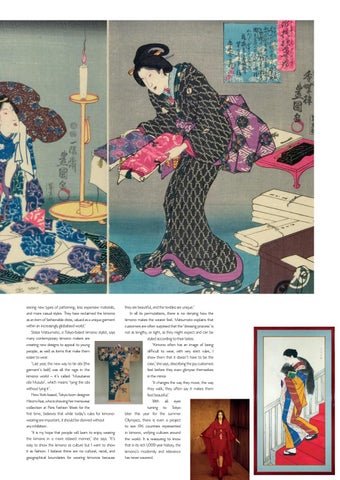seeing new types of patterning, less expensive materials, and more casual styles. They have reclaimed the kimono as an item of fashionable dress, valued as a unique garment within an increasingly globalised world.’ Stasia Matsumoto, a Tokyo-based kimono stylist, says many contemporary kimono makers are creating new designs to appeal to young people, as well as items that make them easier to wear. ‘Last year, the new way to tie obi [the garment’s belt] was all the rage in the kimono world – it’s called ‘Musubanai obi Musubi’, which means ‘tying the obi without tying it’. New York-based, Tokyo-born designer Hiromi Asai, who is showing her menswear collection at Paris Fashion Week for the first time, believes that while today’s rules for kimonowearing are important, it should be donned without any inhibition. ‘It is my hope that people will learn to enjoy wearing the kimono in a more relaxed manner,’ she says. ‘It’s easy to show the kimono as culture but I want to show it as fashion. I believe there are no cultural, racial, and geographical boundaries for wearing kimonos because
they are beautiful, and the textiles are unique.’ In all its permutations, there is no denying how the kimono makes the wearer feel. Matsumoto explains that customers are often surprised that the ‘dressing process’ is not as lengthy, or tight, as they might expect and can be styled according to their tastes. ‘Kimono often has an image of being difficult to wear, with very strict rules, I show them that it doesn’t have to be the case,’ she says, describing the joy customers feel before they even glimpse themselves in the mirror. ‘It changes the way they move, the way they walk, they often say it makes them feel beautiful.’ With all eyes turning to Tokyo later this year for the summer Olympics, there is even a project to see 196 countries represented in kimono, unifying cultures around the world. It is reassuring to know that in its rich 1,000-year history, the kimono’s modernity and relevance has never wavered.
